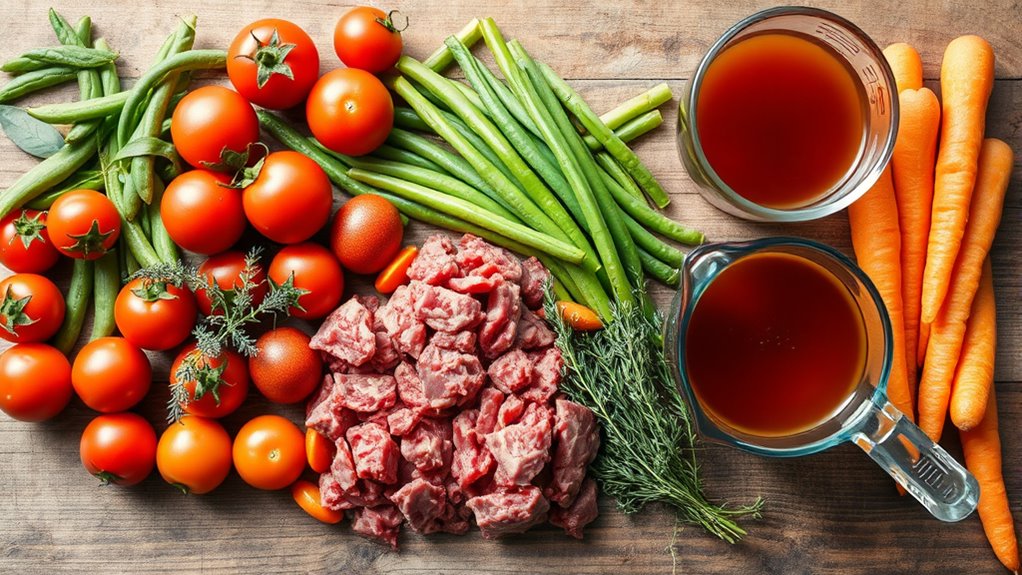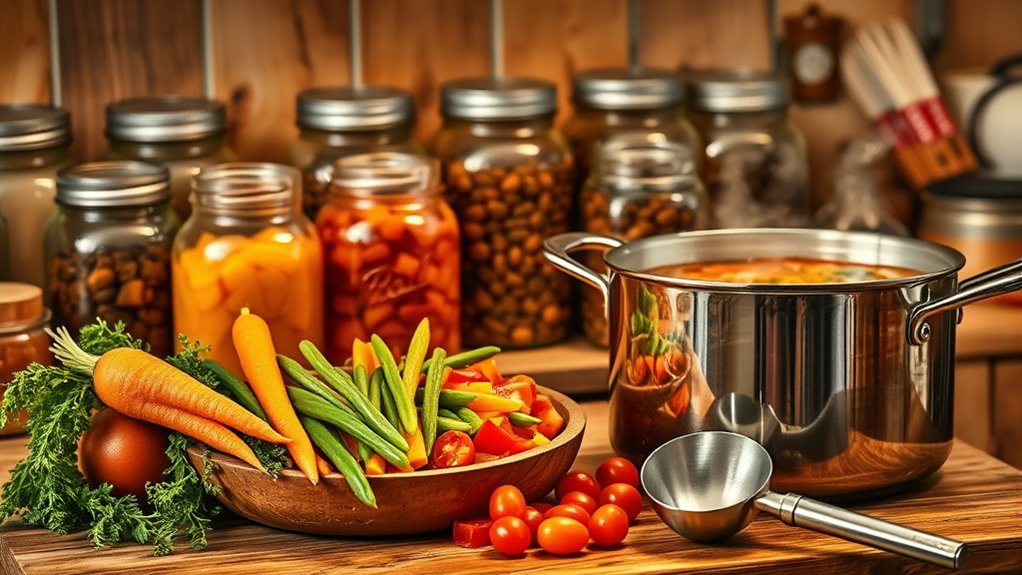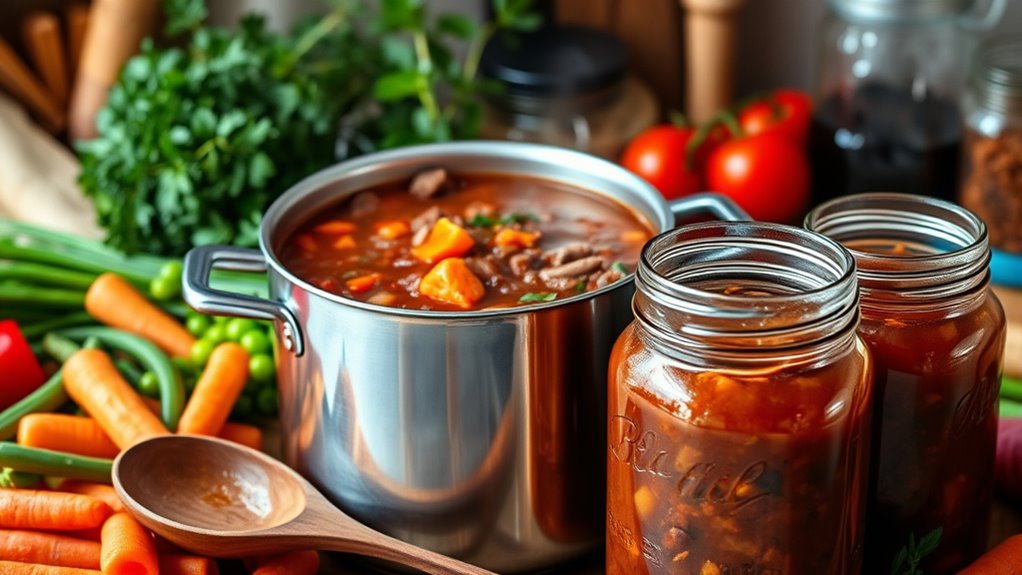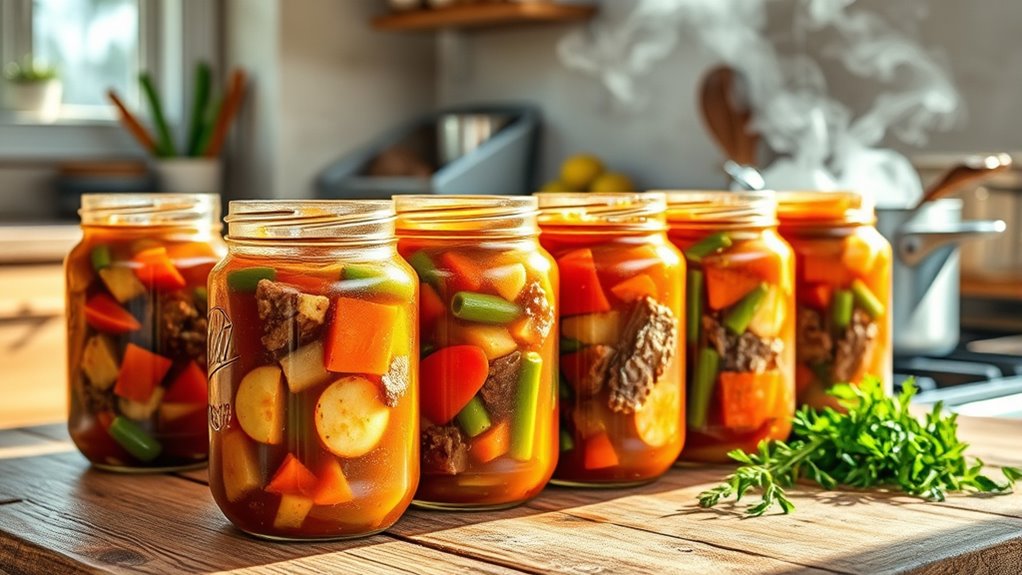To safely can vegetable beef soup, start with lean beef chunks, carrots, celery, potatoes, and onions, all trimmed and diced. Brown the meat for depth, then deglaze the pan and simmer with low-salt broth to develop flavors. Pack hot into sanitized jars, leaving proper headspace, and process in a pressure canner at the recommended PSI for your altitude. Use a thermometer to verify temps and remember to vent and seal carefully—more precise steps await.
Ingredients and Quantity

The ingredients and quantities for this Vegetable Beef Soup are listed below with clear, exact measurements to guarantee consistent results. You’ll use fresh vegetables and quality beef cuts, chosen for flavor and tenderness. Gather precise amounts to confirm reliable canning outcomes and even texture.
| Item | Quantity | Notes |
|---|---|---|
| Beef cuts (stew meat) | 2 pounds | Trim fat; cut into 1-inch chunks |
| Carrots | 3 medium | Diced |
| Celery | 2 stalks | Sliced |
| Potatoes | 2 cups | Cubed |
| Onion | 1 medium | Chopped |
You’ll also need garlic, tomatoes, broth, and seasonings. Measure accurately, blend flavors, and maintain safe processing temperatures for consistent results. Fresh vegetables deliver brightness; beef cuts supply body and depth.
Preparations

To prep this Vegetable Beef Soup, start by organizing your ingredients and equipment from the previous section. You’ll implement precise prep techniques that guarantee safety, efficiency, and consistent results. Focus on clean handling, measured quantities, and fresh-to-use items for reliable flavor.
- Prep techniques: wash, trim, and dice vegetables to uniform sizes
- Ingredient selection: choose lean beef, fresh produce, and low-salt broth
- Sanitation steps: sanitize surfaces and hands before processing
- Temperature control: keep ingredients cold until just before heating
- Time management: stage tasks to streamline the canning process while preserving nutrients
Kitchen tools or Kitchenware Required

Choosing the right kitchen tools matters as much as picking ingredients: you’ll need a sharp chef’s knife, a sturdy cutting board, a large heavy pot or Dutch oven, a wide sauté pan, and basic measuring tools to guarantee consistent results.
Essential tools support safe, efficient canning and prep. Canning equipment, including jars, lids, rings, a canner, and a rack, assures proper preservation. Kitchen safety dictates heat-proof gloves, a long-handled spoon, tongs, and a thermometer for precise temps. A timer helps track processing, while a colander, ladle, and funnel streamline filling. Parchment or silicone mats protect surfaces. Digital scales and measuring cups promote accuracy. Storage containers keep tools organized, reducing contamination risk and error in your workflow.
| Tool type | Purpose | Tip |
|---|---|---|
| Canner | Heat processing | Maintain steady rolling boil |
| Jar kit | Sterilization | Inspect for cracks |
| Thermometer | Temperature control | Target safe temps |
| Shielding | Safety gear | Use insulated gloves |
How to Cook

- Prep all ingredients and equipment before starting.
- Apply precise cooking techniques to create a balanced flavor base.
- Brown beef thoroughly to develop depth of flavor.
- Deglaze the pan to capture and incorporate fond.
- Add aromatics gradually to prevent bitterness.
- Simmer the mixture gently to allow vegetables to soften without losing texture.
- Use even cuts of vegetables for uniform cooking.
- Monitor heat to avoid overcooking.
- Taste frequently and add salt carefully.
- Balance acidity and sweetness as needed.
- Experiment with small batch soup variations to customize flavors.
- Cool soups promptly for safe canning.
- Maintain clean techniques, consistent timing, and document any adjustments for repeatability.
How to Serve

Serving vegetable beef soup effectively starts with portioning and presentation that respect the dish’s balance. You’ll portion by using standard cup sizes, ensuring consistent calories and texture across servings. Plate or bowl choices should showcase the soup’s color and chunky content without crowding the rim. Serve hot, or maintain a consistent warm temperature to preserve tenderness of beef and vegetables. Include a simple, neutral aroma without overpowering notes to keep flavors honest. For serving suggestions, position a clear ladle alongside the bowl for easy self-serve, and offer a crisp bread or cornbread on the side to balance viscosity. Garnish ideas are optional; if used, keep them modest—parsley, chives, or a tiny dollop of yogurt can add brightness without masking taste. You decide what supports the dish’s integrity.
Tips
Start with a plan for texture and tenderness: cut beef into uniform chunks, brown thoroughly for depth, then simmer long enough to break down connective tissue without overcooking vegetables. You’ll balance richness with safety, applying proven canning techniques to preserve flavor and texture. Precision matters: monitor pressure, adjust time for altitude, and avoid over-thickening broth during processing. For flavor enhancements, layer ingredients thoughtfully and cap fruitless gaps with aromatics.
- Use uniform beef chunks for even tenderness
- Brown thoroughly to deepen flavor without scorching
- Maintain steady simmer before packing for canning
- Add aromatics (onion, garlic, bay) for complexity
- Verify headspace and follow tested processing times
This approach yields reliable texture, robust taste, and confident preservation.
Food Value and Benefit
Vegetable beef soup provides valuable nutrition and practical benefits as a prepared dish. It combines lean beef, a variety of vegetables, and simmered stock to create a balanced meal rich in essential nutrients. This recipe supports steady energy levels and promotes fullness, making it an excellent choice for meal planning and budget-friendly eating.
Vegetable beef soup delivers balanced nutrition, steady energy, and budget-friendly meal planning.
Benefits of eating this vegetable beef soup include:
- Provides a good source of protein for muscle maintenance and repair.
- Supplies dietary fiber that aids digestion and promotes satiety.
- Contains iron, which is essential for oxygen transport in the blood.
- Offers zinc to support immune system function.
- Includes potassium to help regulate fluid balance and blood pressure.
- Delivers antioxidants and phytonutrients from vegetables that may help reduce inflammation.
- Allows control over sodium content by managing stock and seasoning.
- Preserves nutrients effectively when properly canned, ensuring long shelf life without compromising health benefits.
Vitamins and minerals present in this recipe:
- Vitamin A and C from vegetables, supporting vision, skin health, and immune function.
- Iron from lean beef for energy and oxygen delivery.
- Zinc for immune health and wound healing.
- Potassium to maintain fluid balance and cardiovascular health.
- B vitamins from beef, aiding in energy metabolism.
Frequently Asked Questions
How Should I Store Canned Soup After Opening?
Orbits of caution dance in your kitchen: refrigerate promptly, transfer to a sealed container, and use within 3–4 days. Refrigeration tips keep flavors safe; leftover usage matters, reheating evenly before enjoying.
Can I Use Freezer-Safe Containers for Storage Afterward?
Yes, you can use freezer-safe containers for storage afterward. Use freezer-safe alternatives, leaving headspace, cool quickly, and label clearly. Follow storage tips: freeze flat, avoid repeated thaw/freeze cycles, and maintain consistent temperatures for best quality.
Are There Safety Signs Indicating Spoilage in Canned Soup?
Yes. Spoilage indicators include bulging lids, broken seals, spurting liquid, off odors, and visible mold; if any appear, discard. For canning safety, follow guidelines strictly, test seals, labeling, and proper processing times to avoid risks.
Is Pressure Canning Safer Than Water Bath for This Recipe?
Pressure canning is safer for low-acid, vegetable-beef soups; water bath isn’t recommended. You should choose pressure canning to guarantee proper processing times, temperatures, and pathogen control; follow tested guidelines and precise timing for reliable, evidence-based results.
Can I Adjust Meat to Vegetarian Substitutions?
Yes, you can, swapping meat for vegetarian substitutions like beans or tempeh. Guarantee flavor adjustments with extra herbs and veggie stock. Maintain safe processing times, monitor texture, and document your substitutions for reproducible results and consistent quality.
